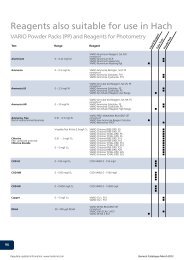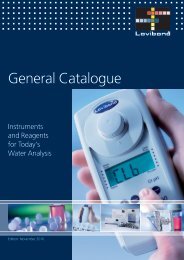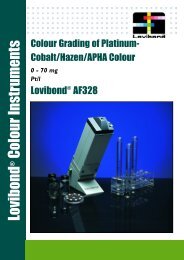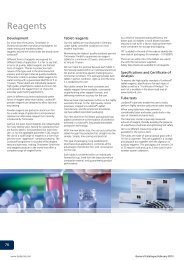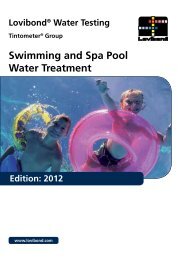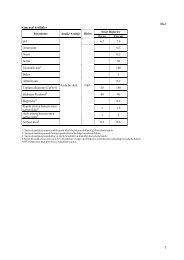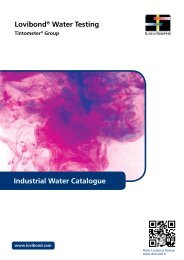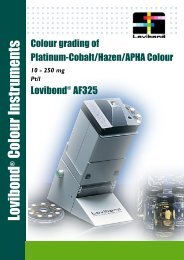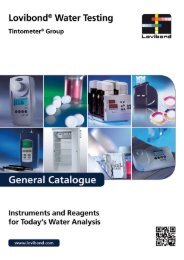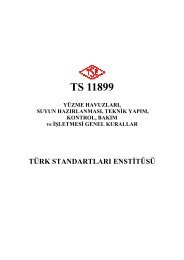Highlights
Highlights
Highlights
Create successful ePaper yourself
Turn your PDF publications into a flip-book with our unique Google optimized e-Paper software.
Tintometer ® -Group<br />
Turbidity meters<br />
Light<br />
Source<br />
Emitted<br />
Light<br />
Detector<br />
Display<br />
22 NTU/FNU<br />
90ϒ Scattered Light<br />
To obtain defined, reproducible results, turbidity<br />
meters are calibrated and adjusted using formazine<br />
solutions (reference standard).<br />
These meters display their results in FNUs<br />
(Formazine Nephelometric Units).<br />
The result measured by a meter operating on<br />
the transmitted light principle is shown in FAUs<br />
(Formazine Attenuation Units).<br />
There are two standards for turbidity<br />
measurement that are widely accepted at an international<br />
level.<br />
EN ISO 7027, "Water quality, determination of<br />
turbidity” outlines all the possible methods for turbidity<br />
measurement.<br />
All optoelectronic methods require an infrared<br />
light source. This also permits testing of<br />
coloured samples.<br />
In its method 180.1, "Determination of turbidity<br />
by nephelometry", the EPA in the US<br />
describes solely the nephelometric (scatter light)<br />
method using a so-called white light source (tungsten<br />
halogen lamp).<br />
The results measured by different units using the<br />
two aforementioned methods cannot be compared.<br />
Sample<br />
Turbidity measurement<br />
The term "turbidity” is used to describe the cloudy<br />
or milky appearance of liquid or solid media such<br />
as water (drinking, mineral, bathing or waste<br />
water), beverages (beer, wine or soft drinks) or<br />
window glass (translucent glass).<br />
In physical terms, turbidity is due to particles of varying<br />
sizes scattering or absorbing light, giving the<br />
medium in question a cloudy appearance.<br />
This turbidity is caused by suspended particles such<br />
as sludge, limestone, yeast or microorganisms.<br />
In former days, researchers attempted to use visual<br />
systems as a means of turbidity measurement.<br />
"Jackson Turbidity Units" (JTU), for example, were<br />
based on a defined volume of dissolved silicic acid<br />
from diatomaceous earth in water. Turbidity was<br />
measured using a candle turbidity meter, apparatus<br />
comprising a candle and a glass vessel that<br />
permitted visual comparison of the suspension<br />
with the silicic acid solution.<br />
Today, it is still common practice to test water<br />
samples using a white "sight disc” made of cast<br />
bronze; the disc is lowered into the water until it<br />
can no longer be seen. The turbidity is then calculated<br />
on the basis of immersion depth.<br />
Today, the phenomenon of turbidity is measured<br />
using optoelectronic meters. An artificial light<br />
source emits a known intensity of light through a<br />
sample. The suspended particles scatter or absorb<br />
the light. The scattered light is then recorded on a<br />
photodetector.<br />
Nowadays, the scattered light is generally<br />
measured at an angle of 90°. This measurement<br />
principle is known as nephelometry. A nephelometer<br />
is therefore a turbidity meter that measures<br />
scattered light at an angle of 90°. The results are<br />
shown in NTU (Nephelometric Turbidity Unit).<br />
114 Regularly updated information: www.tintometer.com General Catalogue July 2009





